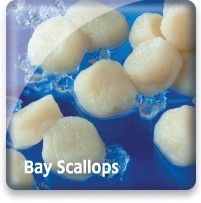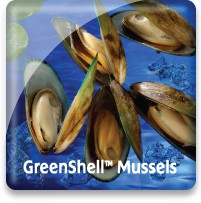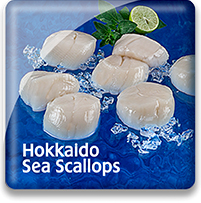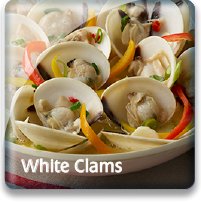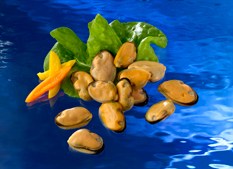
Mussels

Market Name: Eating QualitiesSweet, plump and tender with a somewhat firmer bite than a clam, mussels have a distinctive, rich, sweet taste. Mussel meats should be plump, and color can vary from creamy to brown and orange. If shells are included they should be clean and free of barnacles, stones and other encrustations.
Because mussels are filter feeders, mussel farms can actually improve local water conditions. The mussels remove excess algae, nutrients and sediments as they filter plankton from the water.
Mussels have been cultivated for almost 800 years in Europe, and have been used as a food source for more than 2,000 years.
|
Description & CharacteristicsMussels are found on both the Atlantic and Pacific Coasts of the United States and are a common shellfish throughout Europe. The Blue Mussel, Mytilus edulis, was established in China in the 1970s as a non-native species for aquaculture and wild fisheries. In Chile, the farming of the native Chilean Blue Mussel, Mytilus chilensis, has rapidly grown since the early 2000s. Sea Port In recent years greatly increased its importing of these two Blue Mussel delicacies.Traditionally, washed, live mussels have been sold along the Eastern Seaboard and to a lesser extent along the Pacific Coast. As market acceptance has grown, a number of processors started offering a variety of imported frozen mussel products that expanded the market. Farmed mussels are increasingly important. They offer cleaner product, generally on ropes or stakes and are therefore clear of sea-bottom mud. Farmed product tends to be more consistent in size and meat content than mussels harvested from the wild. Blue Mussels are regularly shaped with light ridges running around their shells. They vary greatly in color from light brown through greenish or dark blue and black. Meat colors also vary from creamy (usually males) to brown and orange (usually females). Shell and meat color offer no indication wholesomeness. The soft parts enclosed by the shells are all edible.Live mussels should be thoroughly cleaned of seaweed, barnacles and other marine debris before they are shipped. It is better, however, to leave the attached black byssal threads known as beards. Removing these, shortens the shelf-life and quality of the live mussel. The beards should, however, be pulled out right before the shellfish are cooked. Today the fresh market for mussels is secondary to that of frozen mussles that are being offered in multiple forms such as extracted cooked, blanched, and raw meats, half shell, and whole cooked vaccum packed. Sea Port's mussels from both China and Chile are offered in these various forms.Raw (not fully cooked) mussels are subject to the controls of the National Shellfish Sanitation Program (NSSP). Raw mussels may only be harvested from approved water, and every company handling them through the distribution chain must be licensed by the state. Bags and other containers of live mussels and raw frozen mussels must carry a tag showing the origin and date of harvest.
Other Resources |
Handling Instructions for Mussels
Our farmed mussels are sourced from New Zealand, China, and Chile and are offered either raw or cooked in the shell or as extracted meats. The following proper handling instructions apply to all of our various frozen mussels. Frozen mussels should be stored at or below 0°F (-18°C) and then thawed properly when ready to cook from the raw state or to consume as a thawed precooked product. Our frozen mussels have an 24 month frozen shelf life. Links to proper seafood handling: NOAA - Fish Watch: Handling Seafood and A Consumer Guide to Safe Seafood Handling.
Thawing Mussels
Our mussels should be quickly thawed by removing them from their package and placing them in a plastic bag or wrap and running them under cold water until thawed. This method works well for both pre-cooked and raw mussels. Raw mussels can also be successfully cooked from the frozen state and the frozen precooked mussels can be directly added to heated preparations with great ease and success. Mussels not consumed immediately after thawing need to be refrigerated between 33 and 39°F and consumed within 1-2 days
Important Instructions for Mussels
Upon complete thawing, gently rinse with cold clean water. Raw mussels that are cooked immediately after this complete thawing or cooked directly from the frozen state will yield the best quality. If the mussels are precooked, the best quality will likewise be evident immediately upon proper thawing.
Mussels must be kept frozen to maintain safety. Persons who are pregnant, immune compromised or suffer from allergies should avoid this product.
Material associated with mussels may be found in this product e.g. pea crabs, mussel beards and fine seaweed. Mussels lock shut when harvested, trapping all their delicious flavor and protecting the meat. Our mussels are then scrubbed and each “exterior beard” (fine “hair like” membranes that bond the mussel to a surface) is shaved off. The interior beard may still be attached, ready for easy removal before or after preparation.
Cooking Tips
Raw mussels are quick and easy to cook in as little as 2-6 minutes by either baking, steaming, boiling, broiling, barbecuing or frying. Cooking raw mussels directly from the frozen state works to help preserve their natural flavors. Precooked mussels offer further convenience and flexibility. This super nutritional food can be spiced and flavored in a variety of ways. However, we believe that light seasoning allows the mussel’s very own natural flavors to take center stage. Links to cooking tips and recipes: Mussel Recipes and Pure New Zealand Greenshell.
Chile
A long, skinny country (2,700 miles long and 110 miles wide), Chile is a land of contrasts. From the Pacific Coast to the high, rugged Andes range that runs the length of the country, Chile has five unique climate zones and growing conditions that favor a wide range of agricultural and fisheries products.
In addition to being the world’s largest exporter of fresh grapes, plums, and fresh fish, Chile is the world’s second-largest producer of farmed salmon.
Wild capture fishery: In addition to such well-known products as Chilean sea bass (Patagonian toothfish), Chilean waters are rich with Merluza (also known as Hake); Congrio; Corvina; swordfish; mussels, scallops, king and snow crab, and surf clams. In addition, Chile is one of the world’s major producers of fishmeal.
Aquaculture: Over the past 20 years, Chile has emerged as an aquaculture powerhouse, becoming the world’s second-largest producer of salmon (Norway is the largest). Salmon species grown in Chile include Atlantic, coho (silver), and some king salmon, as well as steelhead trout). Because of the cool ocean current known as the Humboldt Current, Chile produces salmon in the extreme Southern regions of the Country—equivalent to Madrid and Rome in latitude! These regions are known as the Zona de Los Lagos (Lakes) and Extremo Sur (Extreme South), corresponding with Regions X and XI, and even reaching into Region XI.
China
With more than 1.3 billion people, China is today the world’s most populous country. With a growing economy fueling an appetite for seafood, China has begun importing seafood for in-country consumption, as well as exporting a great deal of its production. In fact, since 2002, China has continued to export more fish and fishery products than any other country in the world, with Japan, the United States, and the Republic of Korea as its main export markets.
Chinese distant water fishing activities started in 1985 when China gained access to new fishing grounds through agreements with foreign countries. China operates vessels in West Africa, the North Pacific, and tuna longline vessels in the South Pacific. In addition, squid are harvested in the Japan Sea, the South Atlantic, and the North Pacific under Chinese-flagged vessels.
Carp are also commercially important, as are bream, shad, eel, catfish, rainbow trout, salmon, whitebait, mullet, mandarin fish, perch, sturgeon, and murrel (snakehead). Commercial shellfish include Saltwater & freshwater shrimp, river crabs, and mollusks such as mussels, clams, oysters, and freshwater snails.
With one-fifth of the world’s population, and an official government policy to promote aquaculture, China has today become an aquaculture powerhouse, now producing more than two-thirds of the world’s aquaculture species. Fish and shellfish are grown in freshwater and saltwater environments.
Go Blue! Seafood Sustainability Spectrum*Click here for an explanation of our Sustainability Spectrum .jpg)
Sustainability AssessmentSea Port imports Mussels from China and Chile. In general, the environmental risks of mussel aquaculture, as with other types of shellfish aquaculture, are limited as long as farms are properly sited, managed, and monitored. Since mussels are filter feeders—meaning they feed by removing small particles, including plankton and other nutrients, from the water column, mussel farming does not require supplemental feed and can actually improve local water quality.
Environmental Impact: LowMussel farming has relatively minimal environmental impacts, provided farms are properly sited and managed, and can potentially improve local water quality. Chilean mussel farming is listed as sustainable by Friend of the Sea and the Marine Stewardship Council, Naturland, and the Global Aquaculture Alliance's BAP program have certified several mussel farms worldwide. The Monterey Bay Aquarium's Seafood Watch program lists Chinese and Chilean Mussels as Best Choices.
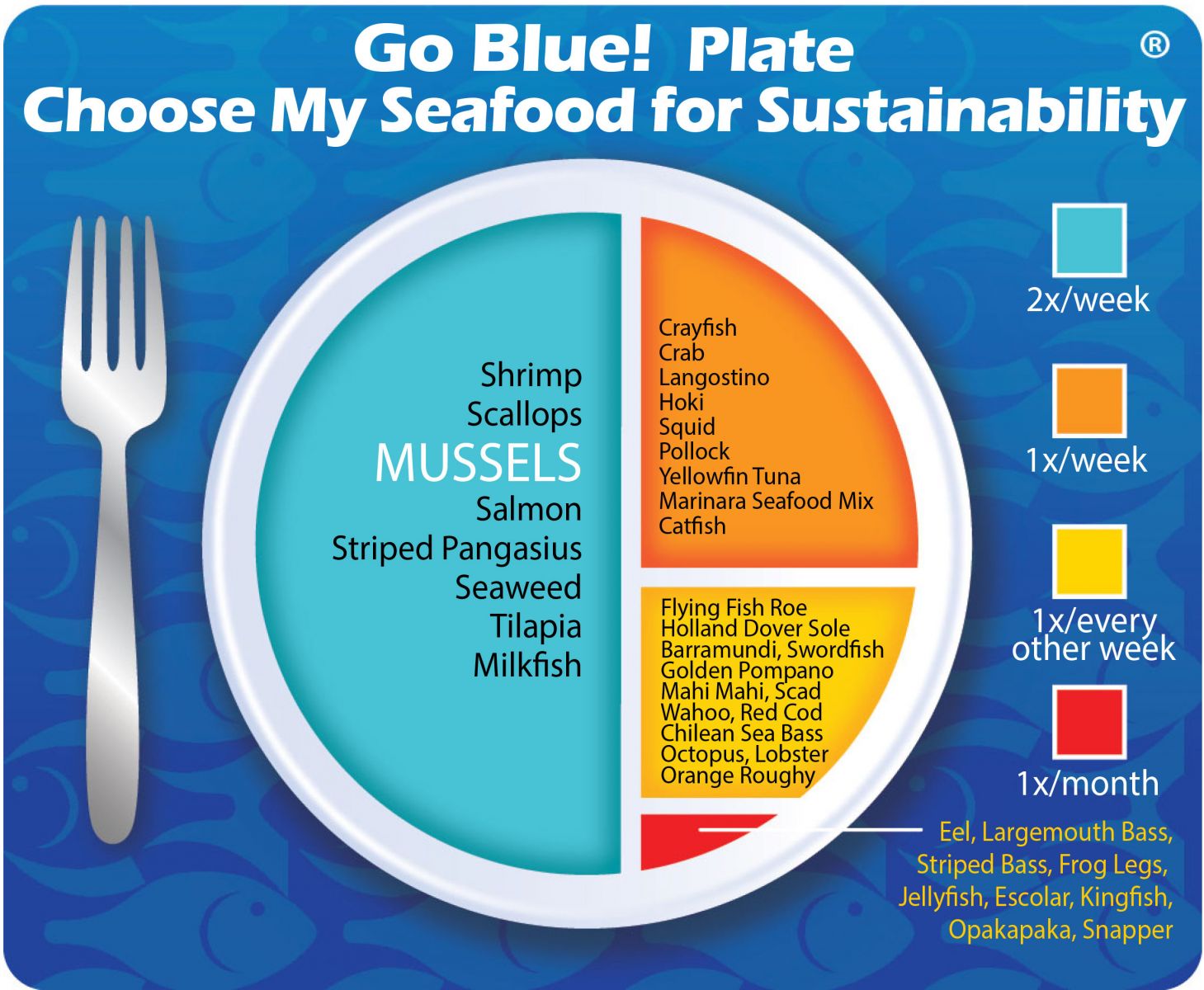
Sustainability Improvements NeededMonitoring of water quality and stocking densities need to be initiated, maintained and improved upon as this farmed low trophic food source expands.
Actions that Sea Port is UndertakingSea Port is aggressively marketing farmed mussels. Sea Port believes that increasing the overall consumption of bivalve mollusks (lower level trophic seafood) will further the protection of our aquatic environments while providing sustainably produced proteins for future generations. Sea Port is a Premier Member of the Global Aquaculture Alliance and as such has supported the advancement of sustainable mussel aquaculture. Sea Port is currently sourcing Chilean Blue Mussels that have been certified as sustainable by both Friend of the Sea and the Marine Stewardship Council. Sea Port believes that, in aggregate, choosing from a diverse variety of seafood is better for sustaining the world’s seafood resources and that Farmed Mussels must be a part of this variety.
We created the sustainability assessments for each of our seafood items in order to reveal the existing and potential environmental impacts and risks that are associated with producing them for human consumption. This allowed us to establish the starting position for each of our seafood items along our progressive Go Blue! Seafood Sustainability Spectrum®. These assessments are only a single snapshot in time and because of this, we will continue to assess and update the critical sustainability needs associated with our supply sources and issue updates to the Go Blue! Seafood Sustainability Spectrum® as needed. There is a growing global awareness for the need to assure the sustainability of farmed and wild caught seafood and because of this; all around the world positive changes are rapidly occurring at all levels of the seafood supply chain. We will continue to spread this growing awareness and work with our many industry partners to improve the sustainability of all seafood, which we believe is the ideal protein of choice to feed an ever growing world population. Our Go Blue! Seafood Sustainability Spectrum® serves as our compass and yardstick as we strive to move all our products forward to becoming more sustainable. Please join us in this committed quest and Catch Our Wave® to sustainability by choosing a diverse variety of responsibly produced seafood as part of your diet at least twice a week.
|


